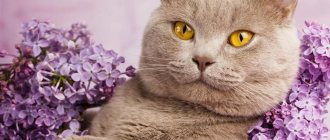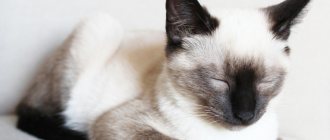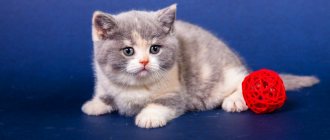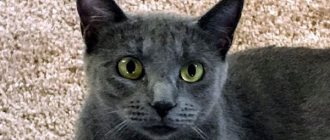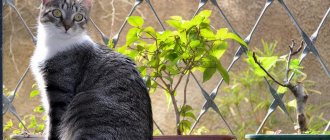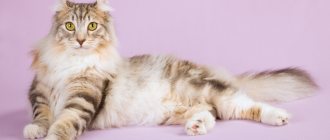Description of the British cat breed
Popularity 7th place among 87 cat breeds
Lifespan:
9-15 years
Height:
33 cm
Country of origin:
Great Britain
Average price:
5-25 thousand rubles
Weight:
4.5-8 kg
Latest articles Cat health
Rabies vaccination for cats: choice of vaccine, necessity, schedule 01/22/2022 4 0 0
Selection and adaptation
TOP 20 best cat breeds for families with children 01/22/2022 25 0 0
Health and susceptibility to disease
British Shorthairs have good immunity and, with proper care, can live for about 15 years. Although these cats are endowed with good health, there is a predisposition to certain diseases in the breed.
Read in detail: “Life expectancy of the British”.
Most often in the British it occurs:
- obesity;
- hypertrophic cardiomyopathy;
- hemophilia B;
- polycystic kidney disease;
- gingivitis.
Key facts
The British cat is a representative of a breed that was mainly a creation of nature, and not the result of human selection. This animal combines excellent external characteristics, a calm character and excellent health. Living in the same house with a British person will bring the owners pleasure from communicating with him.
Individuals of this breed have lived in the UK for a long time, so in their country of origin they are called “shorthair” for short, which means “short-haired”. Indeed, the British cat's coat has a plush feel to the touch; this is a key characteristic of the British cat. In general, they are valued not only for their round, charming muzzle or proportional body. These cats have always been considered excellent mousecatchers.
The description of the British cat breed says that these animals love company, but they are unlikely to ask to be held or lie on your lap. They prefer to have their own space and do not want it to be invaded.
Thanks to good health, the average life expectancy of a British cat is 12-17 years, but there are long-livers who live up to 20 years. Males are slightly larger than females. Thus, the weight of males can reach 5-8 kg, and that of cats up to 4.5-6 kg. The height of the animals at the withers is about 28-32 cm.
Pros and cons of the breed
Like any other cat breed, the British Shorthair has both positive and negative traits.
| pros | Minuses |
| Cleanliness | The need for a balanced diet |
| Friendliness | Predisposition to certain diseases |
| Easy to care for |
The British Shorthair is an attractive cat with aristocratic habits and developed intelligence. This is one of the few animals whose appearance completely matches their character.
The smiling, phlegmatic Briton, who looks like a plush toy, will be an ideal pet for both families and single people.
History of the origin of the British cat
The history of the appearance of cats in Great Britain is covered with the dust of time. Some researchers believe that they sailed on the ships of Roman legionnaires. Cats served as rat catchers there, protecting food in the holds from rodents. However, those animals were graceful in build with long legs and bore little resemblance to modern Britons.
Over time, the imported cats went wild, mixing with local relatives. They helped peasants fight harmful rodents, receiving shelter and food for this. Pet owners did not think about the appearance of the cats, their color, the shape of the tail and ears, so the exterior of the breed was shaped by nature itself.
Only in the second half of the 19th century did people become interested in breeding these beautiful animals. This was due to their increased popularity among representatives of the upper class. This is confirmed by graphic sketches by the Englishman Louis Wayne, in which cats in the role of people play bridge or golf, have a picnic, play music, ride in a sleigh, and read newspapers. Such cheerful drawings captivated the prim Englishmen, and since then the popularity of the breed has only grown.
The first international cat show took place in London on July 13, 1871. It was attended by 170 furry participants with their owners. The procedure for conducting shows and the evaluation system was developed by a passionate lover of mustachioed pets, Harrison Weier. Invited aristocrats and ordinary people were amazed by the elegance of British cats, their beauty and intelligence. The day after the exhibition, a blue tabby named Old Lady became the adornment of newspaper pages. Since then, clubs for cat lovers and the first nurseries for breeding the British breed began to appear everywhere in Foggy Albion.
A terrible situation arose during the Second World War. Then not only people, but also domestic animals died under bombing, from hunger, and infectious diseases. The number of representatives of the breed has decreased significantly. After the war, in order to preserve the breed, they began crossing with Russian Blue and Persian cats. Because of this, the purity of the breed was not officially recognized for a long time. As a result, only in 1970 the British cat was allowed to participate in international exhibitions.
What does a British cat look like?
Everyone knows what a British cat looks like, but not everything is so simple. Purebred individuals have many features that are not noticeable at first glance, which distinguish them from mestizos. In the photo, the British cat does not look as luxurious as in life.
Muzzle
The head of the British breed is quite large, with full cheeks and a round forehead. There is a flat space between your pet's ears. The individual has very expressive eyes. They are large in size and have a round shape. The eyes are widely spaced from each other. The color of the irises depends on the color of the animal itself. They can be green, blue, copper or yellow. There are animals with eyes of different colors.
Cats are characterized by a short, wide, straight nose. According to the standard, the pet's chin and earlobe should form a vertical line. The color of the lobe also depends on the color of the animal's coat.
The ears of a British cat are small in size with slightly rounded tips and straight in shape. They widen towards the base of the skull.
Body type
Animals can be of medium or large build. British cats are 4-6 cm taller than female cats. The weight of male and female individuals can reach up to 4-8 kg.
The body of the animal is folded proportionally. It is powerful due to the strong muscles given to cats from birth. The chest is wide and quite deep. The Briton's back is short, but at the same time massive.
The front and rear legs are straight and stand strictly parallel. They are not very long and have strong bones. The paws are round and powerful. The fingers fit tightly to the pads.
The animal's tail, wide at the base, is rounded at the end. It itself is not very long, but quite thick and powerful.
Coat and color
According to standards, wool is the main feature of the British breed. Thus, the undercoat and main hair are almost equal in length. This is what creates the plush effect. Due to the thick undercoat, the guard hairs cannot fit tightly to the animal's body.
For representatives of the British breed, a wide variety of colors is acceptable. The breed standard allows for approximately 60 color options for a British cat. Solid colors are considered classic. The most popular among them are:
- blue, or lilac color, the basis of which is rich gray for blues or silver with shades of peach or pink for lilacs;
- black and chocolate color, with a slightly lighter undercoat;
- white, which may appear as snow white or beige-cream with a white undercoat.
These days, cats with monochrome colors are quite rare. Therefore, combinations of different colors also have their own names:
- tortoiseshell is a very interesting combination of black and red colors, sometimes with white splashes;
- tabby is the most popular color inherited from wild relatives, combining stripes on the back of the animal, the letter M on the forehead, and a ring in the tail area;
- Chinchilla is a light smoky or gray shade in which the guard hair is not completely colored.
Tabbies have spotted, brindle and marbled patterns. Varieties of the British cat are not distinguished by color or other criteria.
Interesting facts about British Shorthair cats
British shorthair cats are already unusually amazing and fascinating in themselves. Therefore, it is not at all strange that there are many facts that only increase the interest of pets.
Here are a few as examples:
- British cats are independent from people (as they believe). They choose for themselves who will be their friend and who they will never let close to them;
- There are no lop-eared Britons. You can often find the name “British Fold”. It is completely false. Only Scots can have long-eared or straight-eared ears. The British come in short- and long-haired varieties;
- British Shorthairs do not require special care for their coat. The molting of these animals is less problematic than the molting of their close relatives;
- The British have their own opinion on any issue. They need to be raised from early childhood - otherwise the cat will really become the master of the house;
- Animals are not afraid of loneliness. They can remain alone with themselves even for several days. The main thing is to always have a filled bowl nearby;
- According to one version, the image of the Cheshire cat was copied specifically from representatives of the British breed;
- Britons are one of the most ancient cats on earth. Despite its already venerable age, the breed gained worldwide fame and popularity relatively recently;
- Representatives of the British Shorthair breed are true sleepyheads. For the British, the daily sleep norm is 14-16 hours;
- Nowadays, British Shorthairs mostly decorate homes. Previously, the main task of representatives of this breed was to fight rodents. Therefore, the British have very well developed hunting abilities.
And the final interesting fact about these amazing cats is that the British tabby cat is the official representative of the Whiskas brand!
British cat character
British cats are a very unusual combination of the appearance of a plush toy with a rather willful character.
On the one hand, they have a pronounced attachment to the owner, a desire to cuddle up to him, to receive their portion of caresses and strokes. On the other hand, pets do not like intrusion into their personal space. The unobtrusive presence of a person in their life is important to them.
The pet spends a lot of time contemplating the surroundings from the windowsill in the apartment, and if the cat lives in a country house, it will find a convenient place for observation in the yard.
The Briton gets along well with other animals. He easily makes friends with cats, dogs, and is calm about pet birds or fish. But in any communication or game, a purebred individual will want to be a leader and will try to show his superiority.
Discreet and also very silent adult pets have a great time with children. They steadfastly endure an excess of affection from the little man.
Some owners note sudden moments of cat activity. They can run around the house at high speed after a real or imaginary object.
The character of the British cat is generally balanced, and the animal can suit almost any family.
Character and habits of British Shorthair cats
British shorthair cats are quite peculiar animals. They are very calm and flexible, but at the same time they treat others in a special way. The British have their own attitude towards their owners. And, if there is a representative of this breed in the house, then he is the owner.
The character of cats is very aristocratic (which is fully explained by the history of their origin). Animals are independent, arrogant and majestic. If you are looking for a pet that will constantly cuddle, ask to be held and purr, throw away the idea of buying a Briton. Such animals will not rub against you even if they are very hungry. The only action they will take when hungry is to sit next to an empty bowl.
Interesting fact: British Shorthairs do not like to be held or cuddled for long periods of time. However, they will happily settle down somewhere on the bed next to their owner. But only of your own free will!
In general, the nature of the animals is peaceful and calm. The British rarely tear their throats out with meows or run around the house out of boredom. Most often they can be found sleeping, eating, or languidly looking out the window. Animals are a little withdrawn, but quickly make contact with people (naturally, only with those they like). British Shorthair cats especially love children.
At the same time, kittens (under the age of one year) play well with their little owners, but are capable of inadvertently biting or scratching their “friend.” British adults simply tolerate all the antics of the children and pay practically no attention to it (unless you pull the pet by the tail).
British Shorthair cats can easily withstand solitude. They are waiting for their owner from work and are extremely happy about his return. Such pets are best suited for constantly busy or lonely people. Animals are wary of strangers. To trust a new guest, a Briton needs to take a good look at him. But there is only one way to make friends between a cat and a new pet - leaving them alone in the apartment for at least a day (while you are at work).
Raising a British cat
In fact, the British are almost impossible to train. But they can be made quite well-mannered by teaching the basic rules of living in the house.
The first thing a kitten is introduced to upon arrival at a new place of residence is the litter box. At first the baby will be confused, but the owner needs to patiently monitor his behavior. If the cat is worried and sniffs the corners, he is taken to the litter box. It usually takes a couple of weeks to develop good toilet habits. We must not forget to praise the little Briton, but there should be no concessions for mistakes either.
Weaning your cat off begging, as well as trying to steal from the table, is very important for maintaining good animal health. Human food causes allergies and is also very harmful due to the abundance of spices and preservatives. Creating a proper feeding schedule and a balanced menu will help you get rid of this habit.
If a British cat does not walk outside, then problems arise with its sharp claws. Scratched furniture and damaged interior items become a big problem for an animal that is not trained in time. You need to accustom your baby to a scratching post immediately after entering the house. It is necessary to persistently take your pet to this object whenever you try to sharpen its claws on foreign objects.
Love, patience and stubbornness in the good sense of the word will help the owner of the British breed to raise an obedient pet that will become the pride of the owner.
Looking for a British Shorthair cat? Find your pet from 19 offers Buy as a gift
How to choose the right kitten
It is better to buy a British dog from trusted breeders or in specialized nurseries that breed this particular breed. At the time of sale, the kitten must have a certificate confirming its origin and a veterinary passport with notes on vaccinations.
Little Britons should not show signs of aggression or fear. Cats should be active, playful and moderately curious. Healthy British babies have clear eyes, soft bellies, clean coats and smooth skin without scratching or redness.
Kitten care
Until the age of three months, little British babies live with their mother. By the time they move to a new home, kittens of this breed are already completely independent. They eat many foods, are accustomed to scratching posts and go to the litter box. Therefore, the owners can only show the pet where the bowls with food and the pot with filler are.
To make the little Briton comfortable, they provide him with a place to sleep. For safety reasons, wires, household chemicals, indoor plants, fragile and small things are hidden from the kitten.
British cat health
Possible diseases
Experts classify the British cat breed as healthy individuals. It cannot be said that they never get sick. But there are no genetic diseases unique to the British. These animals are susceptible only to those ailments that affect all purebred animals.
Common heart problems include hypertrophic cardiomyopathy. It causes thickening of the wall of the ventricle, leading to disruption of the functioning of this organ, and if neglected, to death.
A blood clotting disorder is caused by hemophilia. This disease is dangerous due to large blood loss or internal bleeding. In representatives of the British breed, it can occur due to the crossing of closely related individuals. There is no treatment that completely eliminates hemophilia, so they are limited to blood transfusions and the use of iron supplements. Animals with this problem should not be part of the breeding process.
The British inherited the dangerous kidney disease polycystic disease from the Persian cat breed. It is characterized by the formation of tumors filled with fluid, which causes disruption of the urinary system. At the very beginning, the symptoms of the disease are not very noticeable, so they recognize it already at a fairly advanced stage. The only way to help your pet is by surgical removal of single cysts.
Otherwise, drug treatment is used, but it will simply relieve the animal’s pain and prolong its life by only a few months or a year.
Your pet's mouth can be affected by gingivitis, a disease that causes inflammation of the gums. If you don't start fighting it right away, it spreads to the ligaments, as well as the bones. As a result, teeth begin to fall out, and the infection spreads through the bloodstream throughout the cat’s body.
Overeating or abuse of treats from the host's table leads to the development of food allergies, as well as dermatitis.
Like all breeds, the British are recommended for comprehensive vaccinations, which are carried out under the supervision of a veterinarian on a schedule. The use of anthelmintic drugs will help get rid of intestinal parasites.
Reproductive health
Before getting a British cat, decide whether you need kittens in the future. If not necessary, then take care of sterilization or castration of the animal at a young age.
The optimal time for these procedures is 1 year of the pet’s life. Before this age, surgery should not be performed, because the reproductive organs of cats and kittens are not yet fully mature. Timely castration has a significant impact on the health of British cats and seals.
In the case of desired offspring, the female is considered ready for pregnancy at the age of one and a half years. Typically, gestation occurs without complications; as a result of childbirth, an average of 4-5 babies are born.
Feeding the cat
British cats are not picky eaters. Therefore, when compiling their menu, you can rely on general principles applicable to representatives of other breeds.
You can find out more about feeding your pet in the article “What to feed British cats.”
Complete diet
When feeding natural products, the British Shorthair's menu is designed so that lean types of meat predominate. Also, the cat must be given:
- boiled vegetables;
- porridge with water;
- eggs;
- dairy products;
- sea fish.
It is strictly forbidden to feed your British cat sweets, baked goods, river fish, pork, sausages and whole milk. Smoked, salty, spicy and fried food, as well as any goodies from the master's table, are forever excluded from the menu of the breed.
When dry-feeding a British Shorthair, select premium, super-premium or holistic class products that do not contain questionable ingredients. Cats of this breed eat Hills, ProPlan, 1stChoice and RoyalCanin well. The daily portion for a Briton is calculated according to the table on the packaging.
Important. The British Shorthair cat should have easy access to a bowl of clean drinking water.
Feeding frequency
British kittens eat less, but more often than adult representatives of the breed. Therefore, when drawing up a regimen, be sure to take into account the age of the pet:
- up to 2 months – 5-6 times a day;
- 2-5 months – 4 times a day;
- 5-12 months – 3 times a day.
A one-year-old British cat is switched to twice feeding.
Vitamins and minerals
The body of a Briton who eats natural foods periodically experiences a deficiency of microelements. To compensate for this deficiency, the cat is given special supplements twice a year to strengthen the immune system, joints and improve the condition of the coat.
To select a vitamin-mineral complex, you need to contact a veterinarian, who will recommend a suitable drug.
Most often, British cats are prescribed:
- 8 in 1 ExcelBrewer'sYeast;
- Ani Vital FeliDerm;
- Beaphar Laveta Super.
On a note. British Shorthair cats that eat high-quality dry food do not need additional vitamins.
Features of feeding and diet
The appearance of a British cat, as well as its physical condition, depends on a properly balanced diet. The owner independently decides what to feed the pet. This can be natural food, ready-made food or a mixed menu.
Natural feeding involves the owner drawing up a special menu that can provide the cat not only with calories, but also with nutrients. It would be a good idea to enrich your food with vitamin and mineral supplements.
The natural type of food includes lean meats: beef, lamb, chicken, turkey or rabbit. The recommended amount of meat products is at least half of the daily diet. Sometimes cats are given boneless sea fish fillets, beef liver or tripe. The rest of the diet should consist of cereals and vegetables.
Among cereals, preference is given to oatmeal, rice or buckwheat. Vegetables are added boiled or stewed. Milk can only be beneficial for kittens up to 6 months old. Adults should receive low-fat fermented milk products and cottage cheese.
British people should not be given:
- sweets;
- flour;
- salted or smoked fish;
- tubular bones;
- river fish.
Ready-made food is convenient to use because it can be stored for a long time, is fully balanced and already enriched with useful substances.
Combined feed is a combination of natural and industrial feed. The only rule that must be followed is not to mix homemade food and purchased food in one feeding.
A British cat should have clean water in his bowl at all times.
Diet of British Shorthair cats
The British are quite voracious pets. Complementary feeding of kittens begins already at 3 weeks of age (not with mother's milk). As soon as the animal becomes more independent, they begin to gradually switch it to wet (canned) food. The transition to dry food is carried out only at 4 months. Most breeders follow this algorithm. Kittens arrive into the hands of new owners already accustomed to food.
There are two ways to feed the British: feed and natural. The first is the simplest, but requires significant investments. Cats can eat dry food all their lives without harm to their health. In this case, you should choose premium mixtures. You cannot save on a new family member. It is not worth feeding an animal if it only eats artificial complementary foods. Of course, a piece of boiled chicken will not kill a cat. But, firstly, its body may malfunction (which will lead to the onset of illness), and secondly, all the microelements necessary for a cat are present in the food - such food is both healthier and more appealing to animals.
If you decide to feed your Briton exclusively natural food, then be prepared to learn the difficult science of “British cooking”.
The animal's basic diet should consist of:
- Meat (low-fat chicken and beef) - boiled, pitted and cut into small pieces;
- Cereals (cats can only have rice, millet, buckwheat, oats) – boiled in the usual way;
- Vegetables (carrots, herbs) – boiled or baked and served as top dressing.
The following foods are strictly prohibited for the British: pork, smoked meats, flour, sausages, and fatty fish. With this method of feeding, it is necessary to observe the ratio of vitamins, microelements, as well as the individual preferences of the animal. Your pet's menu should periodically include boiled eggs, chicken liver, and dairy products. You should not forget about drinking - clean and fresh water should always be in the bowl of a British shorthair cat.
Care and maintenance
The British give their owners a lot of joy, but they also require a lot of attention. What causes the most trouble is their thick, very dense coat. It is not prone to tangling, tangles do not form on it, but the fur still needs regular combing. Carry out the procedure no more than twice a week, using a soft brush with natural bristles. During seasonal shedding, which occurs in spring and autumn, lost hair is combed out more often. This helps prevent excessive hair from appearing on furniture, carpets and clothing.
Veterinarians recommend occasionally giving your animal tablets to dissolve hair. When licking, especially during the molting period, cats swallow hair. Once in the stomach, they are practically not excreted and cause problems in the gastrointestinal tract.
Washing your British cat with special shampoos should not be done too often. The coat of the breed has a natural fatty coating, which serves as a barrier to the development of infections and the penetration of bacteria. If necessary, bathing is carried out very carefully, trying not to get water into the eyes or ears.
The cat's ears and eyes need to be wiped with a cotton pad soaked in a special lotion. To remove dirt and discharge from the eyes, you can use cooled boiled water. The cleaning procedure must be carried out at least once a week.
No more than once a month, the claws are trimmed with special nail clippers, and then polished to remove any roughness with a nail file.
Unlike most decorative breeds, British cats can be walked outside. The individual's good immunity allows him to take long walks, but in large cities there is a serious danger of being attacked by stray dogs or being run over by cars. To avoid accidents, wear a harness and leash on your cat.
In any case, cats of the British breed require sufficient physical activity to prevent pet obesity. The tendency to overeat can be corrected by following feeding standards and portion sizes.
Caring for and maintaining a British cat will not become a problem if you train yourself to regularly carry out hygiene procedures with your animal.
Vaccinations and antiparasitic treatment
To protect a British cat from viral diseases, it is regularly vaccinated with a drug that produces immunity:
- to panleukopenia;
- calcivirus;
- rhinotracheitis.
A kitten of this breed is first vaccinated at the age of 7-8 weeks. After 4 weeks, the Briton will be vaccinated again against the same diseases plus rabies. In the future, vaccination is done once a year.
To prevent diseases transmitted by parasites, the British cat is systematically treated for fleas and helminths:
- Antihelminthic drugs are given to the cat 2 times a year with mandatory repetition after 10-14 days.
- For flea treatment, special drops or shampoos are used. And if a Briton regularly goes for walks, he is additionally protected with an anti-parasitic collar.
Tips for choosing a kitten
Purchasing a British pet in Russia will not cause any difficulties, since this breed is very popular in our country. Unfortunately, due to increased demand, unscrupulous sellers offer animals with hereditary diseases and unclear pedigree. Only experienced breeders, as well as specialized nurseries, can sell decent British kittens.
The kitten should be taken from its mother no earlier than two and a half or three months. By this time, the baby’s immunity will be stronger, and he will develop the skills necessary for independent living. After two months of age, cats receive their first comprehensive vaccination and rabies vaccination. This must be reflected in the veterinary passport.
Before purchasing, it is important to observe the behavior of your future pet and take a closer look at its fur. It should be smooth and shiny. Eyes should be clean and free of inflammation. The belly should be soft and covered with silky hair. Meet the kitten's parents and ask for pedigree documents. If everything is in order, the acquired baby will bring you only joy.
History of the breed
The very name of the breed seems to make it clear where the animal comes from, but not everything is so simple. It is impossible to say unequivocally that England is the homeland of these cats. Of the existing versions and assumptions about their origin, not a single one can be confidently called reliable. It is assumed that British cats lived throughout the vast expanse of the Roman Empire, and then somehow found their way to Europe. There is a version that the animals came from France - they were kept on ships as rat catchers. It can be said that one of the most popular breeds of the cat family does not have a confirmed pedigree of its ancient origin. But the recent history of these animals is known and documented.
Until the 18th century, the formation of the breed occurred naturally - that is, without human participation. This is how cats appeared, whose appearance was characterized by the following features:
- stocky body;
- wide muzzle;
- thick, plush-like fur.
In the 19th century, due to their cute appearance, these animals attracted the attention of breeders. Particularly successful attempts to improve the breed were the experiments of Harrison Fair. At the 1871 exhibition, a short-haired tabby cat was presented. Although she won, more than two decades passed before the breed was recognized. The official pedigree of the British Shorthair breed dates back to 1898.
Tabby or merle color looks unusual and is considered popular
During the First World War, British Shorthairs almost completely disappeared. Animals of this breed are preserved only by breeders. After World War II, attempts to breed these cats were resumed: they were crossed with Russian Blues, Persians and other breeds, which gave interesting results. Europe has long recognized the existence of the British breed, and it was the United States’ turn. These animals received worldwide recognition in 1950.
British Shorthairs appeared on Russian territory in the 1970s, but became widespread only in the 21st century.
How much does a British cat cost?
The cost of a British baby directly depends on the popularity of the nursery, the pedigree of the parents, and compliance with appearance standards. The color of the individual may also affect the price. Some of the most common are blue or chocolate kittens with yellow eyes. But color-point chinchillas and chinchillas with emerald irises are sold much more expensive.
Sellers will offer a cat suitable as a companion for no more than 3-10 thousand rubles. If the baby acts as a breeding animal or in exhibitions, then the price of a British cat will reach 35-50 thousand rubles.
Do you like the article? 0
Breeding British Shorthair cats
Breeding purebred British dogs is quite a profitable and interesting activity. Breeders are working to increase the number of these cats. Breeding British shorthair cats begins with the purchase of a breeding (i.e. purebred, thoroughbred) individual. The process of finding a partner for an animal is quite long and labor-intensive. In addition to the ideal pedigree, the future parent of the offspring must be completely suitable for the companion. Cats don't always happen the first time.
In addition to the breeder, breeders are also involved in creating British offspring. What is the difference between these specialists? In relation to your business. The former begin breeding only with breeding animals and carefully approach not only the choice of a partner for the cat, but also the owners. The breeders are driven by the desire to earn more money. Most often, they breed non-pedigreed (not purebred) British and pay little attention to where the kids will live in the future.
Important fact: If possible, you should contact the breeder to purchase an animal. Such a person is guaranteed to provide you with a purebred cat, provide full training on its maintenance and provide a documentation package.
The breeding of British Shorthair cats is not regulated by any specific law. This action is allowed in all countries. Animals are bred in accordance with relevant certificates and standards. As a rule, the first mating occurs at the age of 10-12 months (with breeding - 16-20 months). Animals reproduce over a period of 7-8 years.
